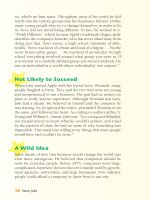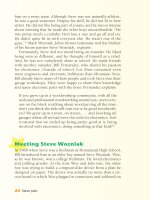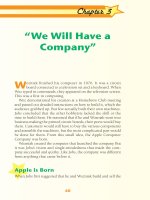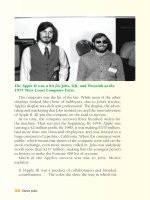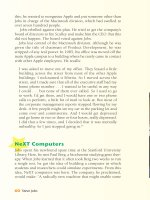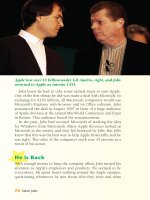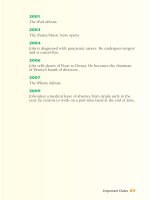Steve Jobs.Other books in the People in the News series phần 7 ppsx
Bạn đang xem bản rút gọn của tài liệu. Xem và tải ngay bản đầy đủ của tài liệu tại đây (515.25 KB, 10 trang )
60
Steve Jobs
this, he wanted to reorganize Apple and put someone other than
Jobs in charge of the Macintosh division, which had swelled to
over seven hundred people.
Jobs rebelled against this plan. He tried to get the company’s
board of directors to fire Sculley and make him the CEO. But this
did not happen. The board voted against Jobs.
Jobs lost control of the Macintosh division. Although he was
given the title of chairman of Product Development, he was
stripped of any real power. In 1985, his office was moved off the
main Apple campus to a building where he rarely came in contact
with other Apple employees. He recalls:
I was asked to move out of my office. They leased a little
building across the street from most of the other Apple
buildings. I nicknamed it Siberia. So I moved across the
street, and I made sure that all of the executive staff had my
home phone number . . . I wanted to be useful in any way
I could . . . but none of them ever called. So I used to go
to work. I’d get there, and I would have one or two phone
calls to perform, a little bit of mail to look at. But most of
the corporate management reports stopped flowing by my
desk. A few people might see my car in the parking lot and
come over and commiserate. And I would get depressed
and go home in two or three or four hours, really depressed.
I did that a few times, and I decided that it was mentally
unhealthy. So I just stopped going in.
45
NeXT Computers
Jobs spent his newfound spare time at the Stanford University
Library. Here, he met Paul Berg, a biochemist studying gene ther-
apy. When Jobs learned that it often took Berg two weeks to run
a single test, he got the idea of building a computer in which
students and researchers could simulate experiments. From this
idea, NeXT computers was born. The company, he proclaimed,
would make: “A radically new machine that might enable some
Down but Not Out
61
obscure kid to simulate a multimillion dollar microbiology labo-
ratory on his screen and then find a cure for cancer.”
46
In September 1985, Jobs officially left Apple, taking five mem-
bers of his Macintosh team with him. He sold all but one share
of his stock in the company to fund NeXT. He immediately hired
the most gifted engineers he could find. Like his Macintosh team,
these engineers, too, believed that their work would change the
world.
Of course, Jobs demanded that everything at NeXT precisely
fit his vision. The building that housed the company had to be
an architectural masterpiece. The factory had to be kept spotless.
And the computer itself had to have revolutionary technology
and impeccable style.
This demand for perfection cost Jobs $10 million in the first
After leaving Apple in 1985, Jobs launched NeXT
computers.
62
Steve Jobs
Tech Talk
T
he world of computers has a language all its own. Here
are a few computer terms and their meaning:
application: A software program that runs on a
computer.
BASIC: A popular computer programming language used
in the creation of software.
bit: The smallest unit of data in a computer.
byte: A unit of data equal to eight bits. Bytes are used
to measure file size and computer memory.
CD-ROM: A compact disk that can be read by a
computer.
Central Processing Unit (CPU): The chip that instructs
the computer on how to run. It is basically the brain
of the computer.
chip or microchip: A tiny electronic device whose
circuitry acts as memory for the computer.
data: Information stored or processed on a computer.
hardware: The actual computer and the components that
comprise it.
motherboard: The circuit board within a computer.
network: To connect two or more computers with
each other so that they can communicate with each
other.
Random Access Memory (RAM): The memory available
to computer programs. For instance, a computer with
10 MB RAM has 10 million bytes of memory.
software: Programs that can be run on a computer.
Down but Not Out
63
three years. It also slowed down the completion of the computer,
which was not released until 1988. It was a sleek black cube
with groundbreaking multimedia capabilities such as full motion
video, animation, and the ability to record and store voice mes-
sages. However, these innovations came at a steep price. The
computer cost $6,500, much more than the average college pro-
fessor or student could afford. And, although universities were
impressed with the machine, most universities received donated
business computers for free, so they were reluctant to purchase
Jobs’s creation. The computer did not sell and the company that
Jobs thought would be his greatest triumph was losing money.
Pixar
At the same time that Jobs was starting up NeXT, he got involved
in another business venture. In 1986, he bought controlling
shares in the computer graphics division of Star Wars producer
George Lucas’s film company for $10 million. At the time, the
company, which Jobs renamed Pixar, was developing computer-
generated imagery, which they hoped would replace tradition-
al special effects and hand-drawn animated movies. They had
already created a computer and special software for this purpose.
The computer was extremely technical and expensive, costing
$135,000. When Jobs saw their work, he was awestruck.
Jobs got the idea of producing and selling the Pixar com-
puter. He imagined doctors using it to enhance MRI and X-ray
results, or to create three-dimensional images of a patient’s body.
Although such technology is now common, at the time hospi-
tals were reluctant to spend $135,000 for the machine, and the
computer failed to sell.
At the same time, Pixar’s animation division was losing money
at a rapid pace, and it all was coming out of Jobs’s pocket. Jobs
considered shutting down the animation division of the company.
But he believed that given time to develop, computer animation
would change motion pictures. He did not interfere with the
company’s creative division because he knew very little about
computer animation. Instead, he wrote check after check to keep
64
Steve Jobs
Jobs believed that Pixar’s animation division would change
motion pictures and be successful.
Down but Not Out
65
it open. In a few years, he had spent $50 million. In 1988, he
funded the production of Tin Toy, one of the company’s earliest
computer animated films. According to Young and Simon, “It
was a pivotal moment in Pixar’s history.”
47
Tin Toy would go on
to win an Oscar for the best animated short film and would be
the inspiration for Pixar’s first full-length movie, Toy Story. But
those successes were still in the future.
Ups and Downs at Home
Steve’s personal life was also having its ups and downs. In 1986,
his mother Clara Jobs died of cancer. His father had died years
earlier. His mother’s death hit Steve hard. He found that working
helped him deal with his grief.
At the same time, new people were entering his life. He had
accepted his daughter Lisa into his life and was on amiable terms
with Chris-Ann. His long-term search for his birth parents led
him to Joanne Simpson, his birth mother, and his sister Mona
Simpson, with whom he became quite close.
In 1989, he met Laurene Powell at a lecture he gave at Stanford
University, where she was a graduate student studying business
administration. Jobs was immediately struck by Powell’s beauty
and made a point of speaking to her. He found that she was as
intelligent as she was attractive, and she was a vegetarian, like
Jobs. The two hit it off immediately. “We walked into town,” Jobs
explains describing their first date. “And we’ve been together
ever since.”
48
The couple was married in a Buddhist ceremony in Yosemite
National Park on March 18, 1991. The wedding was like Jobs,
unconventional and informal. The couple’s first child, Reed, a
son named after Reed College, was born in September 1991.
Two daughters followed, Erin in 1995 and Eve in 1998. Jobs had
finally become a traditional family man, and he loved it. He could
often be seen in-line skating with Lisa, playing ball with Reed,
or pushing a baby carriage around the home in Palo Alto where
the Jobs family lived.
66
Steve Jobs
Success from Failure
Unfortunately, Jobs’s businesses were not going as well as his per-
sonal life. Pixar and NeXT were losing a combined $60 million a
year. In order to turn things around, Jobs made dramatic changes
in both companies. He closed the hardware and sales division of
NeXT, turning the business into a software company intent on
developing a computer operating system able to compete with
Microsoft’s newly released Windows, which it did.
The Disney/Pixar collaboration Toy Story was a huge hit
and made Jobs a billionaire overnight.
Down but Not Out
67
At the same time, he sold the computer division of Pixar, but
left the creative computer animation division intact. He believed
that someday it would change the motion picture industry.
“Pixar’s vision was to tell stories—to make real films,” he explains.
“Our vision was to make the world’s first animated feature film—
completely computer synthetic, sets, characters, everything.”
49
Until that happened, Pixar was costing Jobs a fortune. After
Tin Toy won an Academy Award, he got help. In 1991, Jobs man-
aged to convince the Disney corporation to fund, promote, and
distribute three full-length Pixar movies, a miraculous feat of
persuasion since Pixar was losing so much money.
Four years later Pixar came out with Toy Story. It was a smash
hit. As Jobs imagined, its success launched the computer-
animation film industry.
Taking advantage of the movie’s popularity, Jobs took the com-
pany’s stock public. It was a bold action because the company
was not yet turning a profit. But the public believed in Jobs. The
initial price for the stock was $22 per share, but the demand was
so great that it rose to $39 per share in just one day. Jobs, who
owned thirty million shares, became a billionaire overnight.
Return to Apple
In the decade since Jobs’s departure, Apple also had its ups and
downs. By 1996, the company was losing money. It had also lost
its reputation as an unconventional, cutting-edge company. Apple
computers no longer boasted an innovative design, or the same
attention to detail they had been known for.
Sculley had been forced out in 1993. The new CEO, Gil
Amelio, thought that Apple computers needed a new innovative
operating system. He wanted Apple to buy NeXT to get their
operating system. He also wanted to rehire Jobs. He thought
bringing Jobs back would excite the public and raise Apple’s sales.
“I’m not just buying software. I’m buying Steve Jobs,”
50
Amelio
said at the time.
Although he rarely talked about it, Jobs still missed Apple. A
few months earlier, when Karen Steel, a former Apple employee
68
Steve Jobs
who followed Jobs to NeXT, returned to Apple, Jobs wistfully told
her: “It must feel like you’re going home.”
51
Jobs secretly longed to go back to the company he had started
in his garage. He was even more eager to unload NeXT, but he
was too shrewd to let Amelio know how he felt. Driving a hard
deal, Jobs got Apple to pay him $377.5 million dollars for NeXT
plus 1.5 million shares of Apple stock, a very high price for a los-
ing company. As part of the deal, Jobs agreed to return to Apple
as an informal advisor. It was December 1996. Much to his joy,
Steve Jobs was going home.
69
Chapter 5
Into the Future
W
hen Steve returned to Apple, the company was in sham-
bles. Jobs’s innovative ideas not only saved the company
but took Apple to new heights. Today it is one of the most suc-
cessful corporations in the world, which is largely due to Jobs.
Befriending a Rival
Apple lost $1.6 billion under Gil Amelio. When Jobs saw the
mess the company was in he started campaigning for change. In
July 1997, the board of directors fired Amelio and offered Jobs
the CEO slot. He turned down the offer but agreed to serve as
interim (temporary) CEO. He also turned down the board’s offer
of a huge salary, opting for one dollar a year instead. This was not
unusual for Jobs. He had not taken a salary at NeXT, and his top
salary at Pixar was $50. Jobs had more money than he needed.
He was more interested in getting Apple back on track than in
getting richer. Jobs explains: “I was worth about over a million
dollars when I was twenty-three and over ten million dollars
when I was twenty-four, and over a hundred million dollars when
I was twenty-five and it wasn’t that important because I never did
it for the money.”
52

